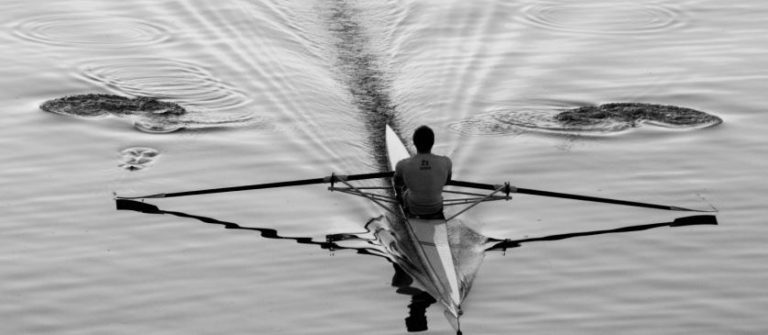Training doesn’t stop just because winter arrives. The winter season is often the best time to build up steady mileage and to get

your body prepared for summer. While rowing is always about passion and fun, rowing in the rain, wind and even snow is not the most pleasurable thing to do. The freezing winter weather does present some challenges and if you want to keep yourself safe and healthy during the breeze, check out this guide for winter rowing clothes.
Picking the right kit
The key to great winter rowing clothing is about wind resistance and the item’s ability to maintain your core temperature. You also want to keep in mind the ability to layer – removing pieces if you’re overheating or easily adding more if you feel cold.
So, let’s look at the layering and some suggestions on what to wear when the cold weather takes over.
Wicking
Your first layer should be all about keeping dry and not allowing the sweat to linger on your skin. You want it to evaporate as quickly as possible in an action referred to as ‘wicking’. The layer should be thin and snug. You could consider items such as UnderArmour’s Tech shirts and pants that are available for both men and women.
Insulation
The second layer is about insulation – keeping your body warm while still allowing the extra moisture to evaporate. A good fabric for the purpose is lightweight fleece or wicking wool.
A vest is a good option, especially if you are wearing a long-sleeved wicking shirt underneath. You can also opt for a full-sleeved top in fleece. The light- and medium-weight fleeces are good options for rowers and you can find them at affordable prices from the gooutdoors.co.uk site.
When selecting the insulation layer, you should opt for clothing that has a partial or full zip. The zip allows you to open up the vest or the top slightly if you find yourself overheating during the exercises.
Protection from wind and water
The final layers should focus on being as lightweight as possible. It also needs to add water and windproof to your kit. If you pick the above two layers correctly, you don’t need to opt for the third layer at all times. The idea is to only wear the third layer if the weather requires it – heavy winds or rain.

Again, you don’t want the garment to prevent the sweat from escaping. Therefore, you need some breathable material, such as GORE-TEX. A good example of the third layer would be the Helly Hansen Crew Jacket for both men and women available at Sailing Clothing Bargains. But remember to pick a short jacket or it’ll catch in your slide as you row.
Covering the extremities
While the above tips will keep your core body warm and protected from the elements, winter also forces you to think about the extremities. Cold weather means your blood is mainly flowing to your core body in order to protect your internal organs. This leaves your toes, fingers, and head vulnerable to the colder air.
Waterproof socks are a blessing – for me, keeping my feet warm and dry adds pleasure to the rowing. And if you suffer cold hands read my Rowing and Reynauds article.
You need to ensure the extremities are less exposed with the help of the same insulating fabrics you used on your second layer. This means getting Rowtex Ice Warm Rowing Gloves and Waterproof Crosspoint socks, for example. Although you can’t always change the size, check your rowing shoes with the socks on to ensure the material doesn’t make the combination too tight. When selecting your gloves, opt for something that provides proper grip to ensure you don’t get blisters. While gloves, good socks and a hat are generally enough, you might want to opt for a hood or neck scarf to ensure your neck is covered if the temperature drops near zero.
Don’t forget to warm up
As well as dressing up appropriately, you should never forget about the importance of a good warm up. You want your muscles to be ready for the weather and if you build a bit of body heat, you won’t strain your muscles once you get in the boat.
Consider lengthening your warm up session slightly, taking tips from the Head Races warm-up routine by Marlene Royle or buying the How to Warm up for Rowing book by Mike Spraklen. In addition, make sure to get on the water as soon as possible if you choose a land-based warmup. This ensures your body doesn’t lose the heat your warm-up has generated – get the gear sorted beforehand!
Keep in mind that you might feel less thirsty in cold weather. Nonetheless, hydration is a big part of a good training session and you definitely need to try remembering to drink regularly while rowing, even if you don’t feel like it. Water will be sufficient for your needs, but if you want, you can also take a sports drink with you.
The above tips will hopefully help you enjoy your winter rowing sessions a bit more. Remember to pick warm clothing, cover up appropriately and don’t forget about those layers!
Rowperfect resources on Winter Rowing
- Winter rowing – keep warm and carry on rowing by Ben Rodford author of Be Your Own Support Team
- How do coaches train athletes to be tough in winter training by Duncan Holland
- Winter Workouts – why do rowers fear the erg? by Rowing Related







This Post Has 3 Comments
Thys Rowing Bikes can be ordered here:
http://eurowsport.co.uk/rowingbike-thys-222-revolver.html
Update
The new address: https://www.eurow.eu/en/various-rowing-related-matters/thys-rowing-bike.html